Introduction to Chair Exercises for Seniors
Chair exercises present a fantastic way for seniors to engage in physical activity, offering a safe, accessible, and effective means to enhance their health and well-being. As we age, staying active becomes increasingly important, yet it also presents more challenges. Traditional forms of exercise may not always be suitable due to limited mobility, balance issues, or other health considerations common among older adults. Chair exercises come as a solution, providing seniors with the opportunity to maintain an active lifestyle, improve fitness, and enjoy the multitude of health benefits that come with regular exercise.
Importance of Physical Activity for Seniors
Physical activity is crucial at any age, but for seniors, it plays a pivotal role in managing and preventing age-related conditions such as arthritis, heart disease, and osteoporosis. Engaging in regular exercise helps to maintain muscle mass, improve endurance, and enhance flexibility. Additionally, it supports mental health by reducing the risk of depression and anxiety, boosting mood, and improving cognitive function.
Advantages of Chair Exercises for Accessibility and Safety
Chair exercises are designed with accessibility and safety in mind, making them an excellent option for seniors, especially those with mobility issues or chronic health conditions. These exercises can be performed from the comfort of home, requiring minimal equipment and space. The use of a chair adds stability and support, reducing the risk of falls and injuries, making exercise more approachable for those who may have previously thought it was out of reach.
Overview of Health Benefits, Including Improved Mobility, Strength, and Balance
Regularly participating in chair exercises can lead to significant improvements in mobility, strength, and balance. Improved mobility enhances the ability to perform daily activities, leading to greater independence. Strengthening muscles not only supports joint health but also increases metabolism, aiding in weight management. Enhanced balance is crucial in fall prevention, a significant concern for seniors, making these exercises invaluable for maintaining overall health and safety.
Getting Started with Chair Exercises: Safety Tips and Setup
Choosing the Right Chair: Stability and Comfort
Selecting an appropriate chair is the first step in safely performing chair exercises. The chair should be stable without wheels and offer enough support to allow you to sit comfortably with your feet flat on the floor and your back supported by the chair.
Understanding Your Limits: Consulting with a Healthcare Provider
Before starting any new exercise regimen, it’s important to consult with a healthcare provider, especially if you have pre-existing health conditions. They can offer guidance tailored to your health needs, ensuring that the exercises you choose are safe and beneficial.
Creating a Consistent Exercise Routine
Consistency is key in reaping the benefits of any exercise program. Aim to incorporate chair exercises into your routine several times a week, gradually increasing the duration and intensity as your fitness improves.
Incorporating Warm-Ups and Cool-Downs for Injury Prevention
Starting each session with a warm-up helps prepare your body for exercise, reducing the risk of injury. Similarly, concluding with a cool-down, including stretches, helps to ease the body back into its resting state, promoting recovery and flexibility.
Top Chair Exercises for Enhancing Strength and Flexibility

Seated Marches for Lower Body Strength
Sit up straight and march your legs up and down in place, lifting your knees as high as comfortable. This exercise strengthens the legs and improves circulation.
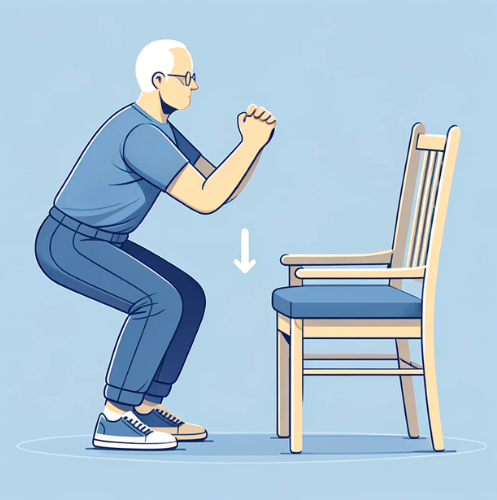
Chair Squats to Improve Leg and Core Muscles
Stand in front of the chair and slowly lower yourself down until you’re just above the seat, then stand back up. This can be done by either facing the chair as shown, or facing away from the chair and stop before your butt touches the chair. This targets the legs and core, building strength and stability.
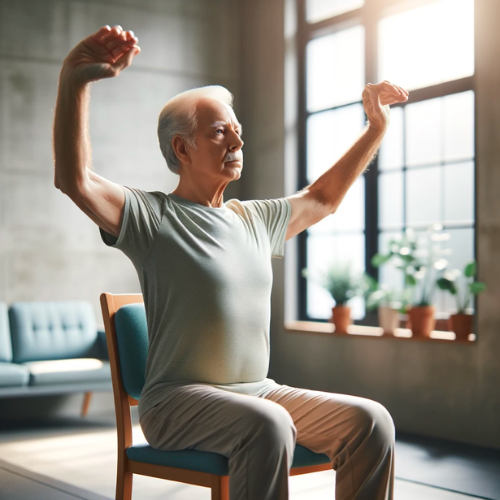
Arm Raises and Stretches for Upper Body Mobility
Sitting or standing, extend your arms out to the sides or overhead, then slowly lower them back down. These movements increase shoulder mobility and upper body strength.
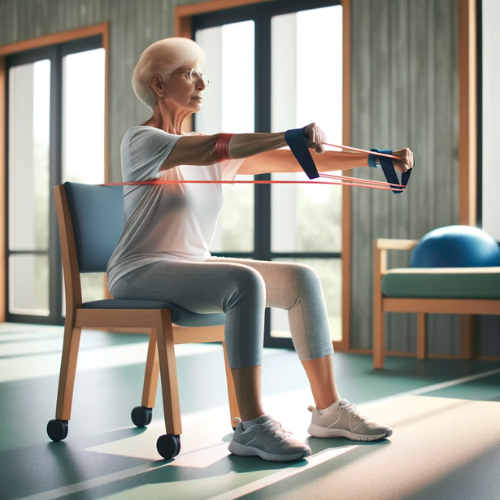
Incorporating Resistance Bands for Added Intensity
Adding resistance bands to your chair exercises, such as during arm raises or leg stretches, can increase the intensity of the workout, promoting muscle strength and growth.
Mindful Movements: Chair Exercises for Balance and Coordination
The Role of Balance in Fall Prevention
Improving balance is essential in reducing the risk of falls, a common cause of injury among seniors. Chair exercises that focus on balance can help enhance stability and coordination.
Seated Twist for Core Strength and Coordination
Sitting in the chair, twist your torso to the left, then to the right, keeping your hips facing forward. This exercise strengthens the core muscles, crucial for balance and coordination.
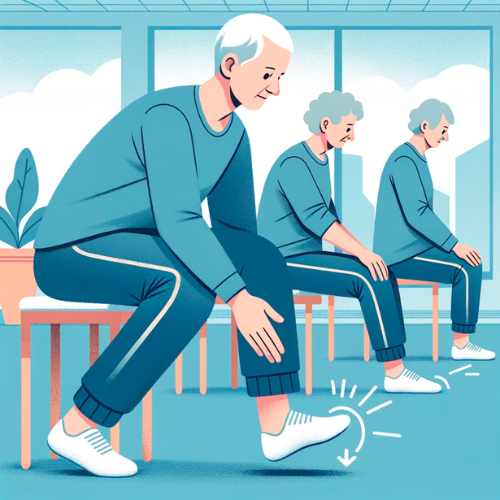
Heel-to-Toe Taps to Boost Balance
Sitting or standing, tap your heel in front of you, then switch to the toe, alternating feet. This simple movement challenges your balance and strengthens lower body muscles.
The Importance of Consistency and Progression in Exercises
Maintaining a consistent exercise routine is vital for seeing improvements in strength, flexibility, and balance. Gradually increasing the complexity and intensity of exercises ensures continued progress and keeps the routine engaging and challenging.
Conclusion
Chair exercises offer a safe, accessible, and effective way for seniors to improve their physical health and overall quality of life. By incorporating these exercises into a regular routine, older adults can enjoy the numerous benefits of physical activity, including enhanced mobility, strength, balance, and mental well-being. Remember to consult with a healthcare provider before starting any new exercise program, choose exercises that match your fitness level, and gradually increase the intensity to avoid injury. With consistency and patience, chair exercises can be a valuable tool in maintaining health and independence in senior years.
For chair exercise demonstrations, it’s recommended to look for videos from reputable sources such as senior fitness experts or health organizations. These can often be found on platforms like YouTube or health websites, providing visual guidance to ensure exercises are performed safely and effectively.
Here’s a little transparency: Our website contains affiliate links. This means if you click and make a purchase, we may receive a small commission. Don’t worry, there’s no extra cost to you. It’s a simple way you can support our mission to bring you quality content.
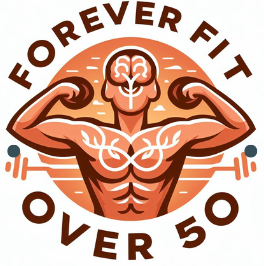
Hi Gary,
The simplicity and accessibility of the exercises you’ve described are just what I’ve been looking for. It’s comforting to know that staying active doesn’t have to be complicated or require a gym membership. I’m particularly intrigued by the idea of incorporating resistance bands into chair exercises for added intensity. It sounds like a great way to spice things up! I’m curious, do you have any recommendations for beginners on how to start slowly and gradually increase the intensity without overdoing it? It’s always a bit daunting figuring out where to start.
Thank you for your work and for sharing these valuable insights.
Warm regards,
Makhsud
Hello Makhsud,
Good to see you back to my blog and your insightful engagement. I’m thrilled that you’ve found the exercises outlined in my article both simple and accessible. Your enthusiasm for staying active, especially with the idea of incorporating resistance bands into chair exercises, is truly inspiring!
Starting slowly and building up gradually is the key to a successful and sustainable exercise routine, especially for beginners. Here are a few recommendations to ensure you increase the intensity at a safe and comfortable pace:
Begin with Basic Movements: Start your journey with basic resistance band exercises that target major muscle groups. Focus on mastering the form without the band first, if necessary, then introduce the lightest resistance band.Frequency Over Intensity: Initially, aim for consistency in your routine rather than intensity. Short sessions, about 10-15 minutes a day, three times a week, can set a solid foundation.Progressive Overload: Gradually increase the intensity by either extending the duration of your workout, increasing the number of repetitions, or using a band with slightly more resistance. This should be a gradual process; for example, consider changes every two weeks or once you feel the current level is no longer challenging.Listen to Your Body: Pay close attention to how your body responds during and after workouts. Mild soreness is normal, but sharp pain is a warning sign. Adjust your routine accordingly, and don’t hesitate to take extra rest days if needed.Diversify Your Routine: As you become more comfortable, introduce new exercises to your routine. This not only prevents boredom but also challenges different muscle groups, enhancing overall fitness.Seek Professional Guidance: If possible, consult with a fitness professional who can provide personalized advice based on your specific needs, capabilities, and goals. This can be particularly helpful in creating a balanced routine that safely increases in intensity.
Remember, the journey to fitness is a marathon, not a sprint. Celebrating small milestones along the way can be incredibly motivating. Thank you for your kind words and for engaging with the content on my blog. Your curiosity and willingness to learn are what make sharing these insights so rewarding.
I’m here to support your journey to a more active lifestyle, so feel free to reach out with any more questions or for further clarification on any of the exercises.
Warm regards,
Gary
Hello Gary,
Great article! I appreciate the comprehensive overview of the importance of chair exercises for seniors, along with the detailed safety tips and setup guidelines. The inclusion of specific exercises for both lower and upper body strength, flexibility and balance is incredibly helpful.
I will be able to share these exercises with my mum. I think she will enjoy this article. I am going to share it with her. I hope she finds it informative and helpful. She does like exercising, but this looks like something nice and easy to incorporate into her lifestyle.
Thank you for sharing this post.
Hello Starlight,
Thank you so much for your kind words and for taking the time to leave such a warm comment. I’m thrilled to hear that you found the article on chair exercises for seniors to be comprehensive and useful. It means a lot to know that the information will directly benefit your mum, especially since it’s designed to be easily incorporated into daily life for enhanced strength, flexibility, and balance.
I hope your mum finds joy and value in these exercises and that they contribute positively to her well-being. It’s wonderful that she enjoys exercising, and I believe these chair exercises will complement her lifestyle beautifully. Please feel free to share any feedback or stories of her experience; I’d love to hear how she gets on.
Thank you again for sharing this article with her, and for your support. Wishing you and your mum all the best on this journey towards health and happiness.
Warm Regards,
Gary